Australia
Commonwealth of Australia | |
|---|---|
| Anthem: Advance Australia Fair Royal anthem: God Save the Queen | |
 | |
| Capital | Canberra |
| Largest city | Sydney |
| Official languages | English (de facto 1) |
| Government | Constitutional monarchy (federal) |
• Queen | Elizabeth II |
| Michael Jeffery | |
| John Howard | |
| Independence from the UK | |
| 1 January 1901 | |
| 11 December 1931 | |
| 3 March 1986 | |
• Water (%) | 1 |
| Population | |
• 2006 estimate | 20,555,3002 (53rd) |
• 2001 census | 18,972,350 |
| GDP (PPP) | 2006 estimate |
• Total | $674.9 billion (17th) |
• Per capita | $32,220 (World Bank) (14th) |
| HDI (2004) | 0.957 very high (3rd) |
| Currency | Australian dollar (AUD) |
| Time zone | UTC+8 to +10.5 (various3) |
• Summer (DST) | UTC+8 to +11.5 (various3) |
| Calling code | 61 |
| ISO 3166 code | AU |
| Internet TLD | .au |
1 English does not have de jure official status (source) 2 mid-2006 population projection using Series B (medium variant) from ABS 3 There are minor variations from these three time zones, see Time in Australia. | |
Australia, officially the Commonwealth of Australia, is a country in the Southern Hemisphere comprising the mainland of the world's smallest continent and a number of islands in the Southern, Indian, and Pacific Oceans. Neighbouring countries include Indonesia, East Timor and Papua New Guinea to the north, the Solomon Islands, Vanuatu and the French dependency of New Caledonia to the northeast, and New Zealand to the southeast.
The mainland of Australia has been inhabited for more than 42,000 years by Indigenous Australians. After sporadic visits by fishermen from the north and by European explorers and merchants starting in the seventeenth century, the eastern half of the mainland was claimed by the British in 1770 and officially settled through penal transportation as the colony of New South Wales on 26 January 1788. As the population grew and new areas were explored, another five largely self-governing Crown Colonies were successively established over the course of the 19th century.
On 1 January 1901, the six colonies became a Federation, and the Commonwealth of Australia was formed. Since federation, Australia has maintained a stable liberal democratic political system and remains a Commonwealth Realm. The capital city is Canberra, located in the Australian Capital Territory. The current national population is around 20.6 million people, and is concentrated mainly in the large coastal cities of Sydney, Melbourne, Brisbane, Perth, and Adelaide.
Etymology

The name "Australia" is derived from the Latin Australis, meaning of the South. Legends of an "unknown land of the south" (terra australis incognita) dating back to Roman times were commonplace in mediæval geography, but they were not based on any actual knowledge of the continent. The Dutch adjectival form Australische was used by Dutch officials in Batavia to refer to the newly discovered land to the south as early as 1638. The first use of the word "Australia" in the English language was a 1693 translation of Les Aventures de Jacques Sadeur dans la Découverte et le Voyage de la Terre Australe, a 1692 French novel by Gabriel de Foigny under the pen name Jacques Sadeur.[1] Alexander Dalrymple then used it in An Historical Collection of Voyages and Discoveries in the South Pacific Ocean (1771), to refer to the entire South Pacific region. In 1793, George Shaw and Sir James Smith published Zoology and Botany of New Holland, in which they wrote of "the vast island, or rather continent, of Australia, Australasia or New Holland."
The name "Australia" was popularised by the 1814 work A Voyage to Terra Australis by the navigator Matthew Flinders, who was the first recorded person to circumnavigate Australia. Despite its title, which reflected the view of the British Admiralty, Flinders used the word "Australia" in the book, which was widely read and gave the term general currency. Governor Lachlan Macquarie of New South Wales subsequently used the word in his dispatches to England. In 1817, he recommended that it be officially adopted. In 1824, the Admiralty agreed that the continent should be known officially as Australia.
The word "Australia" in Australian English is pronounced as /ə.ˈstɹæɪ.ljə/, /ə.ˈstɹæɪ.liː.ə/ or /ə.ˈstɹæɪ.jə/.
History
The first human habitation of Australia is estimated to have occurred between 42,000 and 48,000 years ago.[2] The first Australians were the ancestors of the current Indigenous Australians; they arrived via land bridges and short sea-crossings from present-day Southeast Asia. Most of these people were hunter-gatherers, with a complex oral culture and spiritual values based on reverence for the land and a belief in the Dreamtime. The Torres Strait Islanders, ethnically Melanesian, inhabited the Torres Strait Islands and parts of far-north Queensland; their cultural practices are distinct from those of the Aborigines.
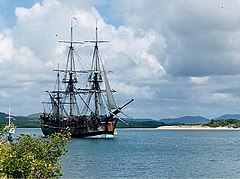
The first undisputed recorded European sighting of the Australian mainland was made by the Dutch navigator Willem Janszoon, who sighted the coast of Cape York Peninsula in 1606. During the 17th century, the Dutch charted the whole of the western and northern coastlines of what they called New Holland, but made no attempt at settlement. In 1770, James Cook sailed along and mapped the east coast of Australia, which he named New South Wales and claimed for Britain. The expedition's discoveries provided impetus for the establishment of a penal colony there.
The British Crown Colony of New South Wales started with the establishment of a settlement at Port Jackson by Captain Arthur Phillip on 26 January 1788. This date was later to become Australia's national day, Australia Day. Van Diemen's Land, now known as Tasmania, was settled in 1803 and became a separate colony in 1825. The United Kingdom formally claimed the western part of Australia in 1829. Separate colonies were created from parts of New South Wales: South Australia in 1836, Victoria in 1851, and Queensland in 1859. The Northern Territory (NT) was founded in 1863 as part of the Province of South Australia. South Australia was founded as a "free province" — that is, it was never a penal colony. Victoria[3] and Western Australia were also founded "free", but later accepted transported convicts.
The transportation of convicts to the colony of New South Wales ceased in 1848 after a campaign by the settlers. [4] Transportation to Western Australia commenced in 1850 and ceased in 1868.[5]
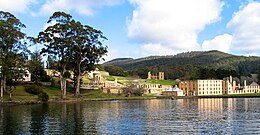
The Indigenous Australian population, estimated at about 350,000 at the time of European settlement,[6] declined steeply for 150 years following settlement, mainly because of infectious disease combined with forced re-settlement and cultural disintegration. The removal of children, that some historians and Indigenous Australians have argued could be considered to constitute genocide by some definitions,[7] may have made a contribution to the decline in the indigenous population. Such interpretations of Aboriginal history are disputed by some as being exaggerated or fabricated for political or ideological reasons.[8] This debate is known within Australia as the History Wars.Following the 1967 referendum, the Federal government gained the power to implement policies and make laws with respect to Aborigines. Traditional ownership of land — native title — was not recognised until 1992, when the High Court case Mabo v Queensland (No 2) overturned the notion of Australia as terra nullius at the time of European occupation.
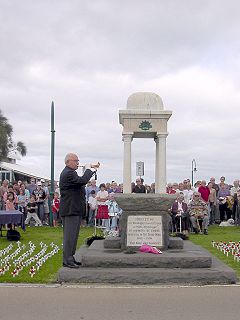
A gold rush began in Australia in the early 1850s, and the Eureka Stockade rebellion against mining licence fees in 1854 was an early expression of civil disobedience. Between 1855 and 1890, the six colonies individually gained responsible government, managing most of their own affairs while remaining part of the British Empire. The Colonial Office in London retained control of some matters, notably foreign affairs, defence and international shipping. On 1 January 1901, federation of the colonies was achieved after a decade of planning, consultation and voting, and the Commonwealth of Australia was born, as a Dominion of the British Empire. The Australian Capital Territory (ACT) was formed from New South Wales in 1911 to provide a location for the proposed new federal capital of Canberra (Melbourne was the capital from 1901 to 1927). The Northern Territory was transferred from the control of the South Australian government to the Commonwealth in 1911. Australia willingly participated in World War I;[9] many Australians regard the defeat of the Australian and New Zealand Army Corps (ANZACs) at Gallipoli as the birth of the nation — its first major military action. Much like Gallipoli, the Kokoda Track Campaign is regarded by many as a nation-defining battle from World War II.
The Statute of Westminster 1931 formally ended most of the constitutional links between Australia and the United Kingdom when Australia adopted it in 1942. The shock of the United Kingdom's defeat in Asia in 1942 and the threat of Japanese invasion caused Australia to turn to the United States as a new ally and protector. Since 1951, Australia has been a formal military ally of the US under the auspices of the ANZUS treaty. After World War II, Australia encouraged mass immigration from Europe; since the 1970s and the abolition of the White Australia policy, immigration from Asia and other parts of the world was also encouraged. As a result, Australia's demography, culture and image of itself were radically transformed. Final constitutional ties between Australia and the United Kingdom were severed in 1986 with the passing of the Australia Act 1986, ending any British role in the Australian States, and ending judicial appeals to the UK Privy Council[10] Australian voters rejected a move to become a republic in 1999 by a 55% majority.[11] Since the election of the Whitlam Government in 1972, there has been an increasing focus on the nation's future as a part of the Asia-Pacific region.
Politics

The Commonwealth of Australia is a constitutional monarchy with a parliamentary system of government. Queen Elizabeth II is the Queen of Australia, a role that is distinct from her position as monarch of the other Commonwealth Realms. The Queen is represented by the Governor-General at Federal level and by the Governors at State level. Although the Constitution gives extensive executive powers to the Governor-General, these are normally exercised only on the advice of the Prime Minister. The most notable exercise of the Governor-General's reserve powers outside the Prime Minister's direction was the dismissal of the Whitlam Government in the constitutional crisis of 1975.[12]
There are three branches of government:
- The legislature: the Commonwealth Parliament, comprising the Queen, the Senate, and the House of Representatives; the Queen is represented by the Governor-General, whose powers are limited to assenting to laws.
- The executive: the Federal Executive Council (the Governor-General as advised by the Executive Councillors); in practice, the councillors are the Prime Minister and Ministers of State.
- The judiciary: the High Court of Australia and other federal courts. The State courts became formally independent from the Judicial Committee of the Privy Council when the Australia Act was passed in 1986.
The bicameral Commonwealth Parliament consists of the Queen, the Senate (the upper house) of 76 senators, and a House of Representatives (the lower house) of 150 members. Members of the lower house are elected from single-member constituencies, commonly known as 'electorates' or 'seats'. Seats in the House of Representatives are allocated to states on the basis of population. In the Senate, each state, regardless of population, is represented by 12 senators, while the territories (the ACT and the NT) are each represented by two. Elections for both chambers are held every three years; typically only half of the Senate seats are put to each election, because senators have overlapping six-year terms. The party with majority support in the House of Representatives forms Government, with its leader becoming Prime Minister.
There are three major political parties: the Labor Party, the Liberal Party and the National Party. Independent members and several minor parties — including the Greens and the Australian Democrats — have achieved representation in Australian parliaments, mostly in upper houses. Since the 1996 election, the Liberal/National Coalition led by the Prime Minister, John Howard, has been in power in Canberra. In the 2004 election, the Coalition won control of the Senate, the first time that a party (or coalition of governing parties) has done so while in government in more than 20 years. The Labor Party is in power in every state and territory. Voting is compulsory for all enrolled citizens 18 years and over in each state and territory and at the federal level.[13]
States and territories
Australia consists of six states, two major mainland territories, and other minor territories. The states are New South Wales, Queensland, South Australia, Tasmania, Victoria and Western Australia. The two major mainland territories are the Northern Territory and the Australian Capital Territory. In most respects, the territories function similarly to the states, but the Commonwealth Parliament can override any legislation of their parliaments. By contrast, federal legislation overrides state legislation only with respect to certain areas as set out in Section 51 of the Constitution; all residual legislative powers are retained by the state parliaments, including powers over hospitals, education, police, the judiciary, roads, public transport and local government.
Each state and territory has its own legislature (unicameral in the case of the Northern Territory, the ACT and Queensland, and bicameral in the remaining states). The lower house is known as the Legislative Assembly (House of Assembly in South Australia and Tasmania) and the upper house is known as the Legislative Council. The heads of the governments in each state and territory are called premiers and chief ministers, respectively. The Queen is represented in each state by a governor; an administrator in the Northern Territory, and the Governor-General in the ACT, have analogous roles.
Australia also has several minor territories; the federal government administers a separate area within New South Wales, the Jervis Bay Territory, as a naval base and sea port for the national capital. In addition Australia has the following, inhabited, external territories: Norfolk Island, Christmas Island, Cocos (Keeling) Islands, and several largely uninhabited external territories: Ashmore and Cartier Islands, Coral Sea Islands, Heard Island and McDonald Islands and the Australian Antarctic Territory.
Foreign relations and the military
Over recent decades, Australia's foreign relations have been driven by a close association with the United States, through the ANZUS pact and by a desire to develop relationships with Asia and the Pacific, particularly through ASEAN and the Pacific Islands Forum. In 2005 Australia secured an inaugural seat at the East Asia Summit following its accession to the Treaty of Amity and Cooperation. Australia is a member of the Commonwealth of Nations, in which the Commonwealth Heads of Government meetings provide the main forum for co-operation. Much of Australia's diplomatic energy is focused on international trade liberalisation. Australia led the formation of the Cairns Group and APEC, and is a member of the OECD and the WTO. Australia has pursued several major bilateral free trade agreements, most recently the Australia-United States Free Trade Agreement. Australia is a founding member of the United Nations, and maintains an international aid programme under which some 60 countries receive assistance. The 2005 – 06 budget provides A$2.5 bn for development assistance;[14] as a percentage of GDP, this contribution is less than that of the UN Millennium Development Goals.
Australia's armed forces — the Australian Defence Force (ADF) — comprise the Royal Australian Navy (RAN), the Australian Army, and the Royal Australian Air Force (RAAF), numbering about 51,000.[15] All branches of the ADF have been involved in UN and regional peacekeeping (most recently in East Timor, the Solomon Islands and Sudan), disaster relief, and armed conflict, including the 2003 Invasion of Iraq. The government appoints the Chief of the Defence Force from one of the armed services; the current Chief of the Defence Force is Air Chief Marshal Angus Houston. In the 2006-07 Budget, defence spending is $19.6 billion.[16]
Geography

Australia's 7,686,850 square kilometres (2,967,909 sq. mi) landmass is on the Indo-Australian Plate. Surrounded by the Indian, Southern and Pacific oceans, Australia is separated from Asia by the Arafura and Timor seas. Australia has a total 25,760 kilometres (16,007 mi) of coastline and claims an extensive Exclusive Economic Zone of 8,148,250 square kilometres (3,146,057 sq. mi). This exclusive economic zone does not include the Australian Antarctic Territory.
The Great Barrier Reef, the world's largest coral reef, lies a short distance off the north-east coast and extends for over 2,000 kilometres (1,250 mi). The world's largest monolith, Mount Augustus, is located in Western Australia. At 2,228 metres (7,310 ft), Mount Kosciuszko on the Great Dividing Range is the highest mountain on the Australian mainland, although Mawson Peak on the remote Australian territory of Heard Island is taller at 2,745 metres (9,006 ft).
By far the largest part of Australia is desert or semi-arid. Australia is the driest inhabited continent, the flattest, and has the oldest and least fertile soils. Only the south-east and south-west corners of the continent have a temperate climate. The majority of the population lives along the temperate south-eastern coastline. The northern part of the country, with a tropical climate, has a vegetation consisting of rainforest, woodland, grassland, mangrove swamps and desert. Climate is highly influenced by ocean currents, including the El Niño southern oscillation, which is correlated with periodic drought, and the seasonal tropical low pressure system that produces cyclones in northern Australia.
Flora and fauna
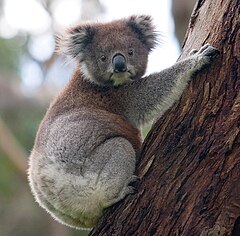
Although most of Australia is semi-arid or desert, it covers a diverse range of habitats, from alpine heaths to tropical rainforests. Because of the great age and consequent low levels of fertility of the continent, its extremely variable weather patterns, and its long-term geographic isolation, much of Australia's biota is unique and diverse. About 85% of flowering plants, 84% of mammals, more than 45% of birds, and 89% of in-shore, temperate-zone fish are endemic.[17] Many of Australia's ecoregions, and the species within those regions, are threatened by human activities and introduced plant and animal species. The federal Environment Protection and Biodiversity Conservation Act 1999 is a legal framework used for the protection of threatened species. Numerous protected areas have been created under the country's Biodiversity Action Plan to protect and preserve Australia's unique ecosystems, 64 wetlands are registered under the Ramsar Convention, and 16 World Heritage Sites have been established. Australia was ranked thirteenth in the World on the 2005 Environmental Sustainability Index.
Most Australian woody plant species are evergreen and many are adapted to fire and drought, including many eucalyptus and acacias. Australia has a rich variety of endemic legume species that thrive in nutrient-poor soils because of their symbiosis with Rhizobia bacteria and mycorrhizal fungi. Well-known Australian fauna include monotremes (the platypus and echidna); a host of marsupials, including the kangaroo, koala, wombat; and birds such as the emu, and kookaburra. The dingo was introduced by Austronesian people that traded with Indigenous Australians around 4000 BCE. Many plant and animal species became extinct soon after human settlement, including the Australian megafauna; others have become extinct since European settlement, among them the Thylacine.
Economy

Australia has a prosperous, Western-style mixed economy, with a per capita GDP slightly higher than the UK, Germany and France in terms of purchasing power parity. The country was ranked third in the United Nations' 2006 Human Development Index and sixth in The Economist worldwide quality-of-life index 2005. In recent years, the Australian economy has been resilient in the face of global economic downturn. Traditionally, the absence of an export oriented manufacturing industry has been considered a key weakness of the Australian economy. More recently, rising prices for Australia's commodity exports and increasing tourism has to some extent alleviated this criticism. Nevertheless, Australia has developed the world's third largest current account deficit in absolute terms (in relative terms over 7% of GDP). This has been considered problematic by some economists, especially as it has coincided with high prices for Australia's exports and low interest rates which keeps the cost of servicing the foreign debt unusually low.[18]
In the 1980s, the Hawke Government started the process of economic reform by floating the Australian dollar in 1983, and deregulating the financial system.[19] Since 1996, the Howard government has continued the process of micro-economic reform, including partial deregulation of the labour market and the privatisation of state-owned businesses, most notably in the telecommunications industry.[20] Substantial reform of the indirect tax system was implemented in July 2000 with the introduction of a 10% Goods and Services Tax, which has slightly reduced the heavy reliance on personal and company income tax that still characterises Australia's tax system.
The total labour force of Australia is 10.66 million [21]. As of January 2007, unemployment was 4.6% with 10,334,800 persons employed.[22] The service sector of the economy, including tourism, education, and financial services, comprises 69% of GDP.[23] Agriculture and natural resources comprise 3% and 5% of GDP but contribute substantially to Australia's export performance. Australia's largest export markets include Japan, China, the United States, South Korea and New Zealand.[24]
Demographics
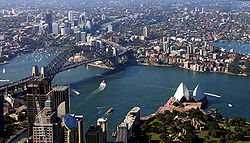
Most of the estimated 20.6 million Australians are descended from nineteenth- and twentieth-century European settlers, the majority from Great Britain and Ireland. Australia's population has quadrupled since the end of World War I,[25] spurred by an ambitious immigration program. In 2001, the five largest groups of the 23.1% of Australians who were born overseas were from the United Kingdom, New Zealand, Italy, Vietnam and China.[24] Following the abolition of the White Australia policy in 1973, numerous government initiatives have been established to encourage and promote racial harmony based on a policy of multiculturalism.[26]
The indigenous population — mainland Aborigines and Torres Strait Islanders — was 410,003 (2.2% of the total population) in 2001, a significant increase from the 1976 census, which showed an indigenous population of 115,953. Indigenous Australians have higher rates of imprisonment and unemployment, lower levels of education and life expectancies for males and females that are 17 years lower than those of other Australians.[24]
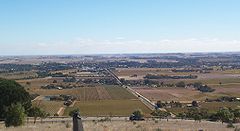
In common with many other developed countries, Australia is experiencing a demographic shift towards an older population, with more retirees and fewer people of working age. A large number of Australians (759,849 for the period 2002 – 03[27]) live outside their home country. Australia has maintained one of the most active immigration programmes in the world to boost population growth. Most immigrants are skilled, but the immigration quota includes categories for family members and refugees.
English is the national language,[28] and is spoken and written in a distinct variety known as Australian English. According to the 2001 census, English is the only language spoken in the home for around 80% of the population. The next most common languages spoken at home are Chinese languages (2.1%), Italian (1.9%) and Greek (1.4%). A considerable proportion of first- and second-generation migrants are bilingual. It is believed that there were between 200 and 300 Australian Aboriginal languages at the time of first European contact. Only about 70 of these languages have survived, and all but 20 of these are now endangered. An indigenous language remains the main language for about 50,000 (0.25%) people. Australia has a sign language known as Auslan, which is the main language of about 6,500 deaf people.
Australia has no state religion. The 2001 census identified that 68% of Australians call themselves Christian: 27% identifying themselves as Roman Catholic and 21% as Anglican. Australians who identify themselves as followers of non-Christian religions number 5%. A total of 16% were categorised as having "No Religion" (which includes non-theistic beliefs such as humanism, atheism, agnosticism and rationalism) and a further 12% declined to answer or did not give a response adequate for interpretation. As in many Western countries, the level of active participation in church worship is much lower than this; weekly attendance at church services is about 1.5 million, about 7.5% of the population.[29]
School attendance is compulsory throughout Australia between the ages of 6 – 15 years (16 years in South Australia and Tasmania, and 17 years in Western Australia), contributing to an adult literacy rate that is assumed to be 99%. Government grants have supported the establishment of Australia's 38 universities, and although several private universities have been established, the majority receive government funding. There is a state-based system of vocational training colleges, known as TAFE Institutes, and many trades conduct apprenticeships for training new tradespeople. Approximately 58% of Australians between the ages of 25 and 64 have vocational or tertiary qualifications[24] and the tertiary graduation rate of 49% is highest of OECD countries. The ratio of international to local students in tertiary education in Australia is the highest in OECD countries.[30]
Culture

The primary basis of Australian culture until the mid-20th century was Anglo-Celtic, although distinctive Australian features had been evolving from the environment and indigenous culture. Over the past 50 years, Australian culture has been strongly influenced by American popular culture (particularly television and cinema), large-scale immigration from non-English-speaking countries, and Australia's Asian neighbours. The vigour and originality of the arts in Australia — films, opera, music, painting, theatre, dance, and crafts — achieve international recognition.
Australia has a long history of visual arts, starting with the cave and bark paintings of its indigenous peoples. From the time of European settlement, a common theme in Australian art has been the Australian landscape, seen in the works of Arthur Streeton, Arthur Boyd and Albert Namatjira, among others. The traditions of indigenous Australians are largely transmitted orally and are closely tied to ceremony and the telling of the stories of the Dreamtime. Australian Aboriginal music, dance and art have a palpable influence on contemporary Australian visual and performing arts. Australia has an active tradition of music, ballet and theatre; many of its performing arts companies receive public funding through the federal government's Australia Council. There is a symphony orchestra in each capital city, and a national opera company, Opera Australia, first made prominent by the renowned diva Dame Joan Sutherland; Australian music includes classical, jazz, and many popular music genres.
Australian literature has also been influenced by the landscape; the works of writers such as Banjo Paterson and Henry Lawson, captured the experience of the Australian bush. The character of colonial Australia, as embodied in early literature, resonates with modern Australia and its perceived emphasis on egalitarianism, mateship, and anti-authoritarianism. In 1973, Patrick White was awarded the Nobel Prize in Literature, the only Australian to have achieved this; he is recognised as one of the great English-language writers of the twentieth century. Australian English is a major variety of the language; its grammar and spelling are largely based on those of British English, overlaid with a rich vernacular of unique lexical items and phrases, some of which have found their way into standard English.

Australia has two public broadcasters (the ABC and the multi-cultural SBS), three commercial television networks, several pay TV services, and numerous public, non-profit television and radio stations. Australia's film industry has achieved critical and commercial successes. Each major city has daily newspapers, and there are two national daily newspapers, The Australian and The Australian Financial Review. According to Reporters Without Borders in 2006, Australia was in thirty fifth position on a list of countries ranked by press freedom, behind New Zealand (19th) and the United Kingdom (27th) but ahead of the United States. This ranking is primarily because of the limited diversity of commercial media ownership in Australia. Most Australian print media in particular is under the control of either News Corporation or John Fairfax Holdings.
Sport plays an important part in Australian culture, assisted by a climate that favours outdoor activities; 23.5% Australians over the age of 15 regularly participate in organised sporting activities.[24] At an international level, Australia has particularly strong teams in cricket, hockey, netball, rugby league, rugby union, and performs well in cycling, rowing and swimming. Nationally, other popular sports include Australian rules football, horse racing, soccer and motor racing. Australia has participated in every summer Olympic Games of the modern era, and every Commonwealth Games. Australia has hosted the 1956 and 2000 Summer Olympics, and has ranked among the top five medal-takers since 2000. Australia has also hosted the 1938, 1962, 1982 and 2006 Commonwealth Games. Other major international events held regularly in Australia include the Australian Open, one of the four Grand Slam tennis tournaments, annual international cricket matches and the Formula One Australian Grand Prix. Corporate and government sponsorship of many sports and elite athletes is common in Australia. Televised sport is popular; some of the highest rating television programs include the summer Olympic Games and the grand finals of local and international football (various codes) competitions.[31]
Environment
Major environmental issues in Australia include Whaling, logging of Old growth forest, Irrigation and its impact on the Murray River, Darling River and Macquarie Marshes, Acid sulphate soils, Soil salininty, Land clearing, Soil erosion, Uranium mining and Nuclear waste, creation of Marine reserves [3], Air quality in major cities and around polluting industries and infrastructure, Pesticide and Herbicide impacts and growing of Genetically modified food.
Climate change and Global warming are of particular concern because of the likely impacts of climate change on agriculture, the Great Barrier Reef and tourism industry, Human health through mosquito borne disease [4]. Sea level rise could also have a profound impact on coastal communities and waterfront suburbs. The range of rises forecast by the IPCC Fourth Assessment Report would be sufficient to have impacts in many areas, and the impact if the Greenland ice cap melts faster than forecast could be disastrous.
In urban areas Noise and Odour are major sources of complaints to environmental protection authorities.
A number of environmental organisations exist in Australia which campaign on environmental issues. Those organisations include Greenpeace Australia Pacific, Australian conservation Foundation, Nature Conservation Council of NSW, Environment Victoria, Conservation Council of Western Australia, and GetUp
See also
References
- ^ Sidney J. Baker, The Australian Language, second edition, 1966.
- ^ Gillespie, R. (2002). Dating the first Australians. Radiocarbon 44:455 – 72
- ^ Convict Records Public Record office of Victoria
- ^ Australian Bureau of Statistics 1998 Special Article - The State of New South Wales
- ^ [http://www.sro.wa.gov.au/collection/convict.asp State Records Office of Western Australia
- ^ Smith, L. (1980), The Aboriginal Population of Australia, Australian National University Press, Canberra
- ^ Tatz, C. (1999). Genocide in Australia, AIATSIS Research Discussion Papers No 8, Australian Institute of Aboriginal and Torres Strait Islander Studies, Canberra
- ^ Windschuttle, K. (2001). The Fabrication of Aboriginal History, The New Criterion Vol. 20, No. 1, September 20.
- ^ Bean, C. Ed. (1941). Volume I - The Story of Anzac: the first phase, First World War Official Histories, Eleventh Edition.
- ^ Australia Act text [1]
- ^ Australian Electoral Commission (2000).1999 Referendum Reports and Statistics
- ^ Parliamentary Library (1997). The Reserve Powers of the Governor-General
- ^ "What happens if I do not vote?". Voting within Australia - Frequently Asked Questions. Australian Electoral Commission. Retrieved 2006-10-21.
- ^ Australian Government. (2005). Budget 2005-2006
- ^ Nation Master [2]
- ^ Department of Defence To Defend Australia (Budget 2006-2007)
- ^ Department of the Environment and Heritage. About Biodiversity
- ^ Colebach, T. We're on a long and slippery slide to disaster, March 2 2005, The Age
- ^ Macfarlane, I. J. (1998). Australian Monetary Policy in the Last Quarter of the Twentieth Century. Reserve Bank of Australia Bulletin, October
- ^ Parham, D. (2002). Microeconomic reforms and the revival in Australia’s growth in productivity and living standards. Conference of Economists, Adelaide, 1 October
- ^ https://www.cia.gov/cia/publications/factbook/geos/as.html
- ^ Australian Bureau of Statistics. Labour Force Australia. Cat#6202.0
- ^ Department of Foreign Affairs and Trade (2003). Advancing the National Interest, Appendix 1
- ^ a b c d e Australian Bureau of Statistics. Year Book Australia 2005
- ^ Australian Bureau of Statistics, Population Growth - Australia’s Population Growth
- ^ Department of Immigration and Multicultural and Indigenous Affairs. (2005). The Evolution of Australia's Multicultural Policy
- ^ Parliament of Australia, Senate (2005). Inquiry into Australian Expatriates
- ^ Department of Immigration and Multicultural Affairs. (1995). Pluralist Nations: Pluralist Language Policies?
- ^ NCLS releases latest estimates of church attendance, National Church Life Survey, Media release, 28 February 2004
- ^ Education at Glance 2005 by OECD: Percentage of foreign students in tertiary education.
- ^ Australian Film Commission. What are Australians Watching?, Free-to-Air, 1999-2004 TV
External links
![]() Wikimedia Atlas of Australia
Template:Wikimapia
Wikimedia Atlas of Australia
Template:Wikimapia
- About Australia from the Department of Foreign Affairs and Trade
- "Australia". The World Factbook (2024 ed.). Central Intelligence Agency.
- Australian Government Entry Portal
- Commonwealth Government Online
- Australian Bureau of Statistics
- Community organisations portal
- Cultural Institutions
- Tourism Australia
- Template:Wikitravel
- Satellite image of Australia (Google Maps)




